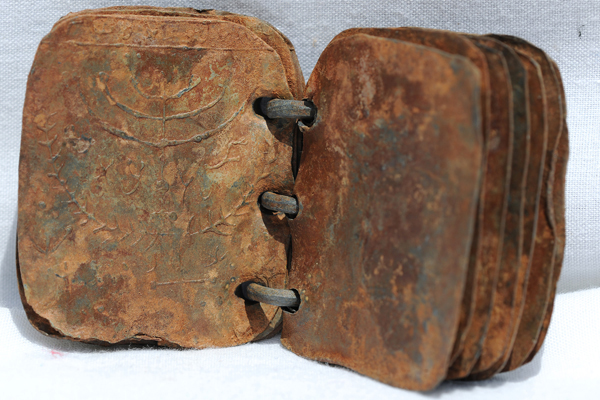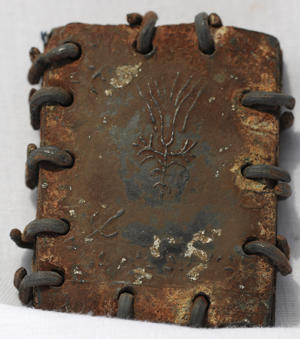Today, I came across a followup on Yahoo! News regarding the 70 credit card sized lead codices which were found in Jordan and thought to be of Christian origin. Many are quick to call this discovery equivalent (or even superior) to the Dead Sea Scrolls. While the jury is still out on just how important (and more importantly how authentic) these codices are to the archaeological and religious world, they are garnering an extremely high interest.
I happened to look at my Google Analytics report for today, and my site visits looked like a parabola. As of 5:00pm today my blog had received over ten (10) times my normal visits, 90% of which hit my site because they were looking for information on the lead codices. My highest entry page was my post on the lead codices, which raised the question as to whether they were Kabbalistic in origin as some have reported, or Christian as most seem to be favoring.
Anyway, back to the followup. According to this article, the codices seem to find an affinity with first century Christianity. It states,
Philip Davies, emeritus professor of Old Testament Studies at Sheffield University, told Pigott he was “dumbstruck” at the sight of plates representing a picture map of ancient Jerusalem. “There is a cross in the foreground, and behind it is what has to be the tomb [of Jesus], a small building with an opening, and behind that the walls of the city,” Davies explained. “There are walls depicted on other pages of these books, too, and they almost certainly refer to Jerusalem.
Quite a description. But is it too good to be true? Only time will tell. I would love to hear your thoughts…
Further Reading
Similar Posts:
- Lead Codices & The Discovery of Atlantis
- Newly Found Lead Codices – Christian or Kabbalistic?
- Asian Christians Speak Out!
- Stone Vessel with ‘Priestly Inscription’ Uncovered In Jerusalem
- The Battle for Jerusalem Has Begun


Pingback: Newly Found Lead Codices – Christian or Kabbalistic? | Digging with Darren
Hopefully they can prove whether or not these are real or not fairly soon. Then… maybe we can get some translations. No doubt that this could be a HUGE find!
Its find they found these. The whole point is what’s on each page? I mean it doesn’t mean anything if they are rotted away.. time to get out the million dollar scanners
I wish we had more images of it – I wonder if there are any text or if it is just images, it is also sad that there are fakes out there.
I remember scholars discussing the Gospel of Judas Iscariotes and arguing that if it was a fake, the perpetrators would have to know as much ancient Greek (was it Greek or Aramaic?) as they did.
Darren Reply:
March 31st, 2011 at 8:15 am
Wendell- Yes, I wish we had more images. However, I’m sure we will have them in time.
FYI, the Gospel of Judas was actually written in Coptic.
Wendell B Reply:
April 1st, 2011 at 8:10 am
Oops, thanks for the input (I should have done a little research before the posting :P)
Hi, I’m one of those who has found their way to your site because of these codices. Interesting site too might I add.
I look forward to reading about the information they get from examining these objects.
Are there other historical examples of metal books from the 1st century like these?
Darren Reply:
March 31st, 2011 at 8:50 am
Ed – the only similar example I can think of (and I’m definitely open to someone chiming in on this…) is the Copper Scroll (no – not a codex) found at Qumran dating from roughly the same time.
Darren,
On the second codex pic you show on this post – which seems like it may be the seven-sealed book the comment on the other post alludes to (though certainly not THE seven-sealed book in Revelation) – the image on the cover (front or back? would the left-to-right/right-to-left divergence have developed so early in codices?) seems to echo the staff of Aaron/pomegranate staff on the coins of the Judaean rebels.
I’ve also noticed some mention and maybe one shot of a cross, which leads me to doubt the Christian application, if ancient. The cross was not an object of visual veneration for some centuries, as I understand.
At least one mention suggests the cross is pictorial (i.e. a drawing of the actual cross with a tomb and Jerusalem pictured in the background), but I’m really not aware of pictorial traditions in late-antique Judaea, so that may bypass my previous reservation.
Thanks for the posts, especially the previous one about the possible Qabalistic purpose of the alledgedly- ancient codices.
http://www.dailymail.co.uk/news/article-1372741/Hidden-cave-First-portrait-Jesus-1-70-ancient-books.html
the picture with : Hassan Saida
Gives me the impression Mr Saida has not come up with this collection from one source only.
I expect he has seen an intial example and have been trying for years to collect more of this kind. His truckdrivers where helpfull to transport the items.
At least it will help the new Holbein or Duerrer to create correct images about the text interpretation of Revelation 5:1;
“a book written inside and on the back”
nice your image of
Nesiat Kapayim
on the top of your page.